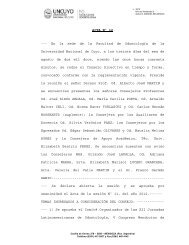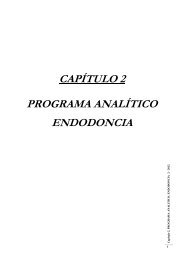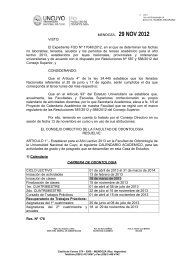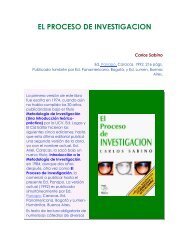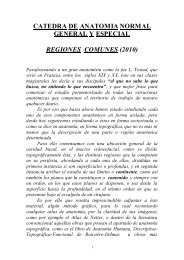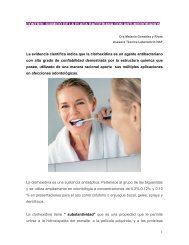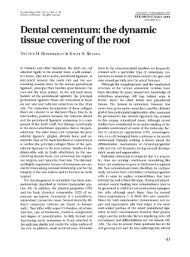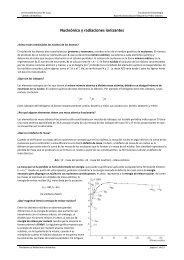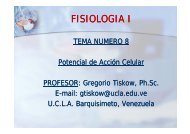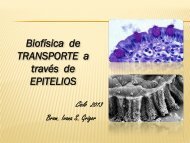CE 1Table—Principles <strong>of</strong> <strong>Suturing</strong>General GuidelinesSutures are usually placed distal to the last tooth and in each interproximal space.Sutures should always be inserted through the more mobile tissue flap first.A circular <strong>for</strong>m <strong>of</strong> needle is used because <strong>of</strong> the restricted space in the mouth.Suture needles should be grasped only by needle holders and the suture needle should be inserted and pulled through the issuein line with the circ l e .Grab the suture needle in the center with the needle holder.The needle shoulder should be placed a few mm from the tip <strong>of</strong> the needle holder.Do not grab the needle at the junction <strong>of</strong> the needle and suture swaged.When penetrating through tissues, the needle should enter at right angles to the tissue.The goal during suturing multiple tissue levels is to suture periosteum to periosteum and tissue to tissue.Pull the suture just tight enough to secure the flap in place without restricting the flap’s blood supply.The flaps should not be blanched when tying a suture.Sutures should be placed no closer than 2 mm to 3 mm from the edge <strong>of</strong> the flap to prevent tearing through the flap duringpostoperative swelling.Suture MaterialsSuture ThreadThe desired qualities <strong>of</strong> a suture threadinclude the tensile strength that is appropriate<strong>for</strong> its respective use, tissue biocompatibility,ease <strong>of</strong> tying, and that it allows minimal knotslippage. It is important that the clinicianselect the specific suture thread and diameterbased on the thickness <strong>of</strong> the tissues to besutured and whether there is the presence orabsence <strong>of</strong> tension-free mobile tissues. 4There<strong>for</strong>e, it seems to this author that suturetechnique and material selection should bebased on a knowledge <strong>of</strong> the desired goals <strong>of</strong>the respective surgical procedures and thephysical and biologic characteristics <strong>of</strong> thesuture thread in relationship to the intraoral invivo healing process.The practitioner has an armamentarium <strong>of</strong>suture materials from which to select <strong>for</strong> useboth intra- and extraorally. Adequate strength<strong>of</strong> the suture material will prevent suture breakage,and proper suture knots <strong>for</strong> the materialused will prevent untimely untying or knot slippage.The clinician also must understand thenature <strong>of</strong> the suture material, the biologicprocesses <strong>of</strong> healing, the biologic <strong>for</strong>ces in thehealing wound, and the interaction <strong>of</strong> thesuture and tissues. This is vital because thepractitioner must ensure that a suture willretain its strength until the tissues <strong>of</strong> the surgicalflaps regain sufficient strength to keep thewound edges together. In those circumstancesin which the intraoral tissues most likely willnever regain their preoperative strength, or thesurgical flaps are not tension-free, the clinicianshould consider using a suture material thatretains long-term strength <strong>for</strong> up to 14 days andresorbs in 21 to 28 days, such as conventionalpolyglycolic acid (PGA) sutures. 2 , 4C o n v e r s e l y, if a suture is to be placed in atissue that heals rapidly (eg, intraoral tissue),the clinician should select a resorbable suturethat will lose its tensile strength at about thesame rate that the tissue gains strength. Thesuture also will be absorbed by the tissue so thatno <strong>for</strong>eign material remains in the wound oncethe tissue has healed, such as the surgical gut orthe new, rapidly resorbable PGA suture material(PGA-FA ) a . 1Two mechanisms <strong>of</strong> absorption result in thedegradation <strong>of</strong> absorbable sutures. First, sutures<strong>of</strong> biological origin, such as surgical gut (eg,plain and chromic gut), are gradually digestedby intraoral enzymes. 2 This suture material ismade from an animal protein and potentiallycan induce an antigenic reaction. When usedi n t r a o r a l l y, this material loses most <strong>of</strong> its tensilestrength in 24 to 48 hours, unless it is coatedwith a chromic compound that extends absorptionup to 7 to 10 days and extends loss <strong>of</strong> tensilestrength <strong>for</strong> up to 5 days. 5Second, surgical gut sutures may break toorapidly to maintain flap apposition, particularlyif used in patients with a very low intraoral pH.A decrease in intraoral pH may be caused by aplethora <strong>of</strong> physiological events, such as meta-aHu-Friedy Mfg Co, Chicago, IL 60618; (800) 483-7433164 Compendium / March 2005 Vol. 26, No. 3
Figures 1—Characteristics <strong>of</strong>simple loop suturingtechnique,CE 1Figures 2—Illustration <strong>of</strong> simple loop suture technique.Figure 3—Illustration <strong>of</strong>the “figure-eight” suturetechnique, which is mostcommonly used in thelingual <strong>of</strong> the lower molara r e a s .Figure 4—Diagram <strong>of</strong>vertical mattress suturetechnique.bolic disorders (eg, epigastric reflux, hiatal hernia,bulimia). Autoimmunity caused byS j ö g r e n ’s syndrome, chemotherapy, radiationt h e r a p y, and some medications (eg, maximumacid output inhibitors and angiotensin-convertinginhibitors, antipsychotics, diuretics,antihypertensive agents, antipsoriasis medications,and steroid inhalers) also can result indry mouth and a low intraoral pH. 2 , 6The minimum coaptation time <strong>for</strong> tissueflaps is approximately 5 days. 5 There<strong>for</strong>e, cliniciansshould select a fast-absorbing PGA suture<strong>for</strong> indications in which there is a low intraoralpH, when surgical gut sutures are contraindicated.The PGA-FA suture material is manufacturedfrom synthetic polymers and principallybroken down by hydrolysis in tissue fluids inapproximately 7 to 10 days and is not affectedby a low intraoral pH. 1,2 The PGA-FA suturealso has a higher tensile strength than surgicalgut suture material; however, it absorbs at a ratecomparable to that <strong>of</strong> surgical gut sutures undernormal intraoral physiologic conditions. 1 , 2Surgical threads, aside from being classifiedby the material they are comprised <strong>of</strong>, also areclassified by thread diameter. Thread materialsrange in diameter from 1 to 10 with the highernumber corresponding to the thinner, moredelicate thread. 7 With periodontal plasticsurgery a 5-0 thread diameter is most <strong>of</strong>ten usedto secure s<strong>of</strong>t tissue grafts and transpositional/sliding pedicle flaps, whereas a 4-0 thread isused to secure most other periodontal mucoperiostealflaps. In implant dentistry a 3-0 threaddiameter is usually used to secure flaps when amattress suturing technique is placed and thena 4-0 thread is used closer to the flap edges tocoapt the tension free flap edges. A 4-0 threadalso is used to secure implant surgical flapswhen interrupted, some mattress sutures, andmost continuous suture techniques have beenp e r f o r m e d .Surgical threads also are fabricated to beeither natural or synthetic nonresorbable materials.Classically, silk has been the most universallyused material in dentistry and many othersurgical disciplines. 8 In this author’s experience,silk is easy to handle, ties with a slip knot,and is relatively inexpensive compared withother nonabsorbable suture materials currentlyavailable. However, there are distinct disadvantageswhen using silk. First, it is nonabsorbableso must be removed, usually a week or so laterwhen the patient is not numb. Second, silkspecifically is a multifilament that “wicks” orpulls bacteria and fluids into the wound site. 9There<strong>for</strong>e, in this author’s opinion, silk is notthe suture material <strong>of</strong> choice when any sterilematerials are placed under a mucoperiostealflap (eg, dental implant, bone graft, or regenerativebarrier) or when there is clinical evidence<strong>of</strong> an infection at the surgical site. Instead <strong>of</strong>Vol. 26, No. 3 Compendium / March 2005165



